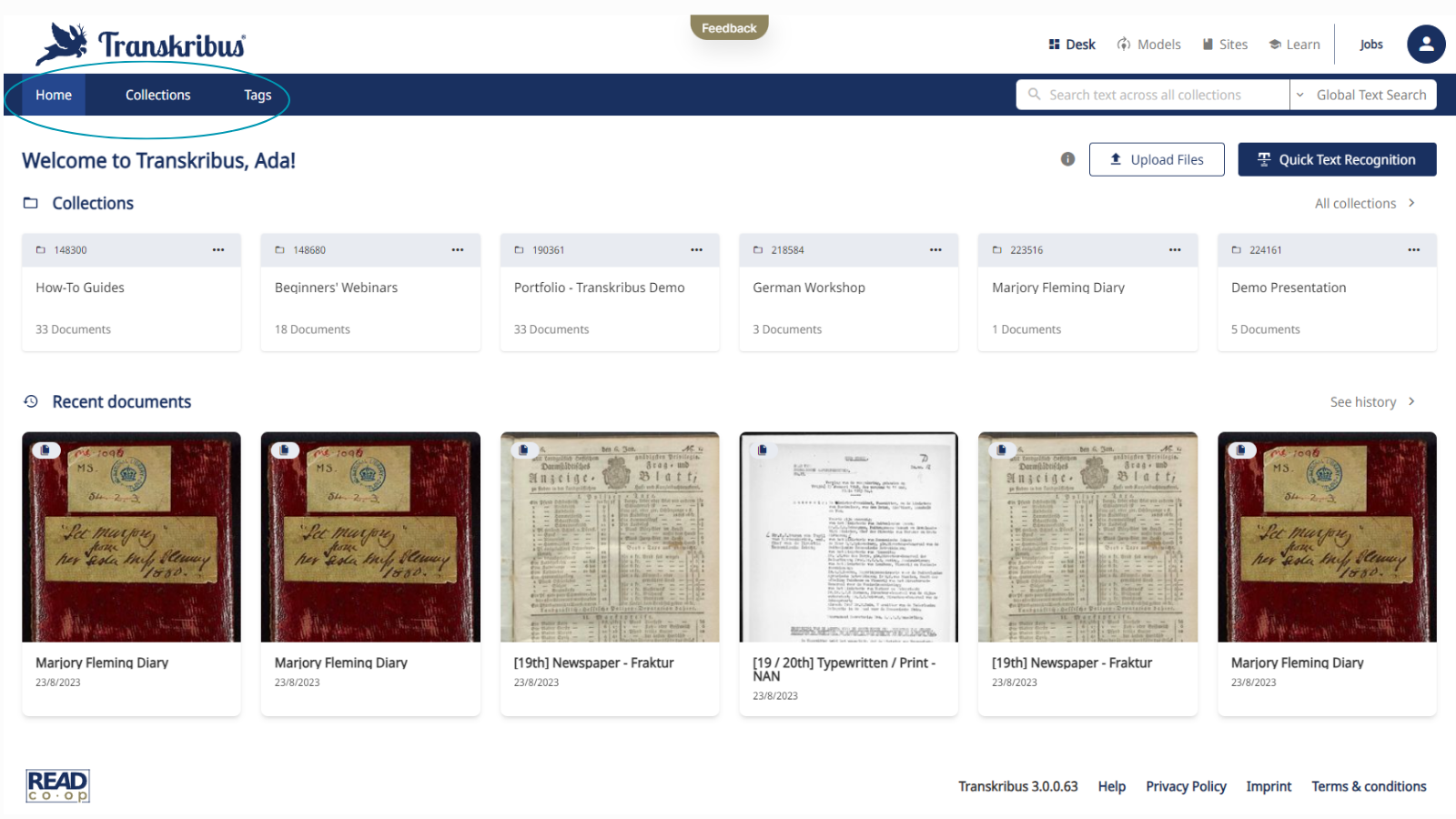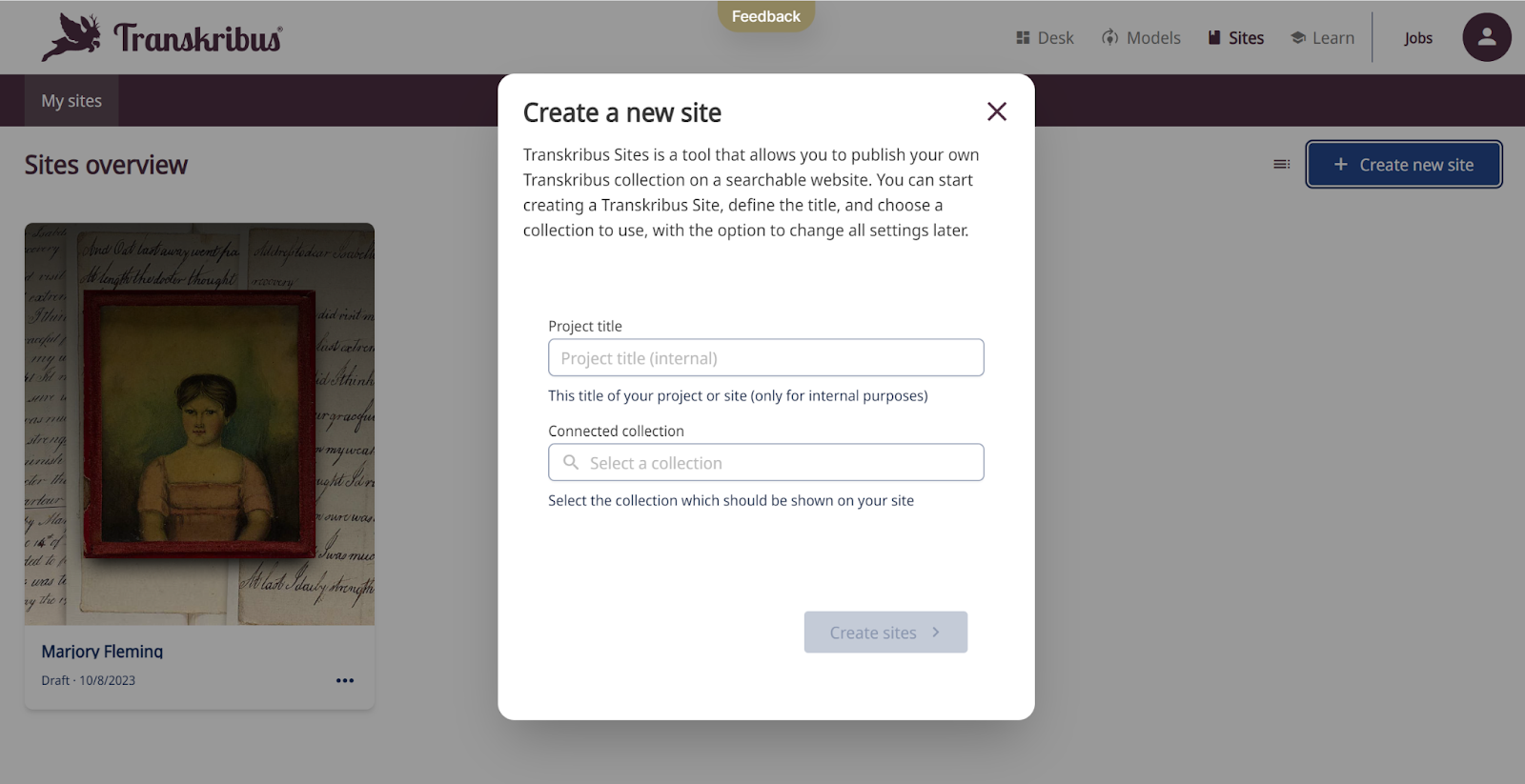.png?width=1280&height=720&name=Featured%20Image%20(9).png)
Introducing the new Transkribus web app
Today, the new Transkribus web app is officially launched!
Transkribus has always worked towards simplifying the digitasion and transcription of historical documents and making them available for research. With the new web app, we are seeking a balance between simplicity, usability and functionality.
To help you get started with the new interface, we will explain all the main changes and what you need to know to make your work with transcribing historical documents more efficient. We will also introduce you to the improved workspaces and show you how to access the new web app.
The new Transkribus platform
The next generation of Transkribus is fully web-based, allowing access to documents from computers and mobile devices. The new web app provides a consistent user experience by integrating tools into organised workspaces that improve navigation through the platform. The web-based Transkribus platform is designed to be user-friendly and easy to learn and use, it’s an important step towards making it easier to digitise historical documents, especially handwritten ones. With frequently used features now more prominently displayed and split into the Workspaces Desk, Models and Sites, the new interface is increasing accessibility and efficiency.
Now, you can navigate between workspaces seamlessly throughout the web app, as the workspaces are part of a fixed header and are visible from all other workspaces..
Plus, Transkribus now has the option to use a more focused and targeted search option, use filter and search options for collections, documents or global search from anywhere in the app, making your searches more effective.

Desk
The first of these new workspaces in the interface is called Transkribus Desk.
Instead of having navigation on the left and top of your page (Lite) or a confusing number of options (eXpert), your navigation on the landing page of the new web application is much simpler. From the Transkribus Desk, you can manage your collections, documents and tags, and easily move to the other workspaces.
From Home, you have direct access to collections and recent documents, where you can upload your documents and try quick text recognition.
In Collections, you can access your existing collections of historical documents and add new ones. As always, within Collections, you can select entire documents or individual pages for automatic recognition.
The Tags section gives you an overview of structural or textual tags and allows you to easily search a collection for them.
What’s new?
- The navigation bar is now at the top of the page for a clearer overview and more structured work.
- One of the functional improvements we have made here is that you can now edit the name and metadata of documents and collections easier, from within the collection or document.
- To give you a better overview of your pages at one look, we have improved the colour coding of the statuses. When opening a document, pages are now more prominently colour-coded according to their editing status (In Progress, Ground Truth…).
- For better accessibility, you can also filter pages by status to help you find the pages you are looking for.
- Customise how you view your documents by adjusting the size of the page preview images in the grid view or choose the table view.
As the Desk workspace is where the users spend a lot of their time, it was important to us to have elements that eliminate extra tasks (editing collection names or metadata from within the collection) and provide a better structure (uniform navigation).
Models
As training models is an important aspect of Transkribus, we have given this feature its own dedicated workspace. In Models you will be able to manage your private models and train new, custom ones. Customisation plays an important role in matching models to individual needs and requirements, as sometimes documents or manuscripts require an own model for their specific writing or layout.

To train a custom model, go to the Models workspace and click ‘Train New Model’. This will show the different model options that are currently available for you to train. Here you will also find the future Field models (available on beta) for improved layout recognition when they become officially available.
Selecting the type of model to be trained will open a new window showing the steps of the training process to start training a custom model.
What’s new?
- The Models Pages provides a dashboard with an overview for the users private Models.
- Another new feature that we will add are new trainable models for improved layout recognition. (Field and Table Models coming soon)
- To make the training process more organised, we have streamlined the process and training steps, giving it a new design and a slight change in the order of training steps.
- Customise your own models by adding descriptions, now you can add thumbnails too.
- Open the Models Gallery to get an overview of all public and private models. In the Model Gallery you can filter and look for public models.

Sites
With the goal of making historical texts more accessible, Transkribus not only assists in the transcription of archival documents but also facilitates their online availability. The launch of Transkribus Sites simplifies this process like never before.
A first version of Transkribus Sites is available already, here on beta.transkribus.eu. Give it a try and set up your very own search website!
Now you can create your own website to share your collections. This Workspace is especially useful for institutions like archives or libraries that want to make historical documents accessible for the public. To get started, move to the Sites workspace to set up your own Transkribus Sites website by clicking on ‘Create New Site’ in the top right corner.
What’s new?
- The advantage of Transkribus Sites is that you will be able to set up a website where people can access and search the documents yourself, without a Transkribus developer having to build it for you.
- Here you can give your project a name, add the collection you want to share and start building it. You can even personalise and customise your Transkribus Sites website with brand colours.
- Maintain the flexibility to change the settings later on according to your preferences.
All about you, the community: Connect & Learn
The community and its contributions play an important role in the development of Transkribus. With a community feature coming next year, user profiles will allow you to tell other users about yourself and your work, and help you find people looking to contribute to or support your projects. Another useful community feature will be Transkribus Learn, which is already available on beta.transkribus.eu. Offering a variety of exercises to learn how to read and transcribe historical manuscripts, as well as the ability to upload your own documents, Transkribus Learn is particularly useful when working with students or volunteers, for example in a citizen science project. It is a guided way to learn to read and transcribe different historical handwriting types.
Your feedback is invaluable
We deeply appreciate our community, as it is through collective effort that we can unveil the richness of the written past. Your feedback is invaluable to us, and we are committed to tailoring Transkribus to meet your specific requirements. We have been eager to hear your thoughts and suggestions for improvement—and we’ve been listening! We encourage you to continue sharing your insights by using the feedback button. Your voice helps us make Transkribus better every day.
We would like to thank our amazing community for supporting Transkribus with their dedication and invaluable input!
How to access the new Web App
As of today, our new Transkribus platform is available online. To access Transkribus, simply open the Transkribus Web App and either create a new account or log in with your existing account details. Once logged in, you already find yourself in the new Transkribus web app!
We are constantly striving to improve your transcription experience, therefore we have chosen a holistic approach and a more intuitive interface for the platform, combining the easy-to-use Lite with the advanced features of eXpert. The launch of the new web app is intended to make your work with Transkribus and historical documents smoother, more efficient and ultimately more enjoyable.
Next Steps
With the official launch of the new Transkribus web app, we are thrilled to embark on the first step toward the next generation of Transkribus. This is just the beginning, and we are well aware that some features present in the eXpert client have yet to make their way to the web platform. Despite this, taking this initial step lays the groundwork for a host of exciting upcoming features like Transkribus Sites, Transkribus Connect, and various citizen science tools.
In line with our future plans, one key addition will be trainable field and table models designed to enhance layout recognition for a variety of documents, such as newspapers, periodicals, logbooks, and forms. We’re also testing Transkribus Sites on beta and look forward to making it available to our entire user community soon.
As for the eXpert client, it will remain accessible but won’t receive any further updates as we will fully focus on improving our web-based platform.
Thumbnail: Transkribus Web App and © Image by Sentavio on Freepik, Free Licence


